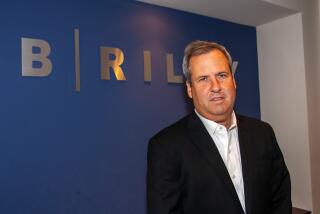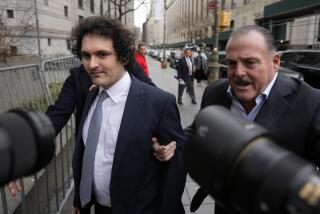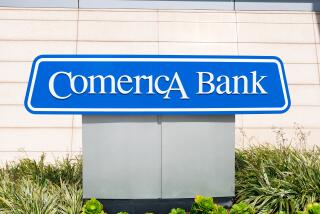Nation’s Biggest S&L; Asks $1.5-Billion Loan Bailout : American Losses Dive in Quarter
- Share via
Financial Corp. of America, the nation’s largest thrift holding company, posted a fourth-quarter loss of $224.6 million today, giving it a negative net worth for the first time, and its chairman asked a government agency for more loan guarantees than were granted to Chrysler Corp. in 1980.
FCA has been reeling from financial difficulties for 3 1/2 years. It has proposed that federal regulators issue up to $1.5 billion in loan guarantees to help it raise capital, chairman and chief executive William Popejoy said.
Preliminary discussions on the proposal are being held between FCA, the parent of American Savings & Loan Assn., and the Federal Home Loan Bank Board that oversees the thrift industry, Popejoy said in a telephone interview.
Board Has No Comment
The bank board had no immediate comment.
FCA is based in Irvine; American is based in Stockton.
FCA’s loss in the most recent period compares to a profit of $23.1 million, or 56 cents per share, in the fourth quarter of 1986.
The loss boosted the company’s deficit to $468 million for all of 1987. The company posted modest earnings of $95.4 million and $53.2 million in the previous two years after suffering a huge loss of $512 million in 1984 when its problems began.
As in recent years, most of the loss in the latest period stemmed from additions to its reserves for loan losses because of the deteriorating value of commercial real estate and condominiums rented as apartments in Texas and other economically depressed regions as well as in California.
Amount for Losses Climbs
FCA’s loan-loss provision for the fourth quarter was $235.5 million, bringing its total to $551.2 million for last year and $1.7 billion since September, 1984.
Despite the dismal 1987 results, Popejoy insisted the company still may be able to restore itself to health. He stressed the need for the federal loan guarantees.
“Our emphasis on raising capital is even stronger now, and we firmly believe in the company’s ability to earn its way out of its problems,” Popejoy said. He estimated such a process could take three to five years.
“We’re talking about an ‘earn-out’ versus a government ‘bailout’ . . . and the successful turnaround of the Chrysler Corp. with government loan guarantees is an excellent example of how we could accomplish similar results.”
Chrysler Turnaround
Chrysler, which was on the brink of collapse in 1980, got $1.2 billion in loan guarantees from the government and repaid money in 1983--seven years ahead of schedule.
The $1.5 billion proposed by FCA would permit the company to meet regulatory capital requirements for the first time since late 1984.
Popejoy said the proposed loan guarantees--in the form of capital certificates that would be issued to FCA by the Federal Savings & Loan Insurance Corp.--wouldn’t preclude a restructuring of FCA or its acquisition by another institution. FSLIC is a quasi-government agency underwritten by the S&L; industry.
Despite Popejoy’s upbeat outlook, the company said its outside auditor, Peat Marwick Main & Co., is expected to issue a qualified opinion with the 1987 financial results, indicating the company’s ability to survive as a viable entity is uncertain.
Because of its most recent loss, FCA’s shareholder equity declined at year-end to a minus $163.4 million, compared to a positive $313.9 million a year earlier and $61.2 million as of Sept. 30.
FCA’s portfolio of soured loans and foreclosed property as of Dec. 31 was $1 billion, down from $1.7 billion a year earlier and a peak of $2 billion on Feb. 28, 1986.
More to Read
Inside the business of entertainment
The Wide Shot brings you news, analysis and insights on everything from streaming wars to production — and what it all means for the future.
You may occasionally receive promotional content from the Los Angeles Times.










